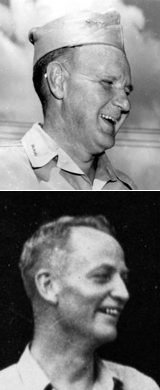Looking northeast across Vella Gulf from Barakoma, Vella Lavella.
RAdm. Wilkinson and Comdr. Burke.

Comdr. Moosbrugger and Comdr. Simpson.

Task Group 31.2 was the destroyer “striking force” attached to the Third Fleet Amphibious Force, which was commanded from 15 July 1943 by RAdm. Theodore (“Ping”) Wilkinson. On 3 August 1943, Comdr. Arleigh Burke was relieved as TG 31.2 commander by Comdr. Frederick Moosbrugger.
On 6 August 1943, TG 31.2 consisted of Destroyer Division 12, less Gridley (under Comdr. Moosbrugger) and Destroyer Division 15 less Wilson (under Comdr. Rodger Simpson).
« « «
The destroyers were drawn from three 1,500-ton classes,
Mahan,
Gridley and
Benham. All carried a main gun battery of four 5-inch/38 cal. but differed in torpedo and secondary amament:
- The three ships of Destroyer Division (DesDiv) 12, operating as Division A-1 under Comdr. Moosbrugger, each carried had initial broadside of eight torpedoes but no secondary armament larger than 20mm guns. Mahan-class Dunlap mounted twelve 21-inch torpedo tubes: one quadruple mount on the centerline between the stacks and one on each wing abaft the after stack. Gridley-class Craven and Maury both mounted sixteen torpedo tubes: two on each wing in the waist, for a broadside of eight “fish.”—ideal for an initial torpedo attack.
- The three ships of DesDiv 15, operating as Division A-2 under Comdr. Rodger Simpson were all members of the Benham class. Lang, Sterett and Stack had originally carried two quadruple torpedo mounds on each side but, by the time of the battle, had had the after tubes replaced by 40mm twin mounts—well-suited to take under fire any barges encountered inshore.


